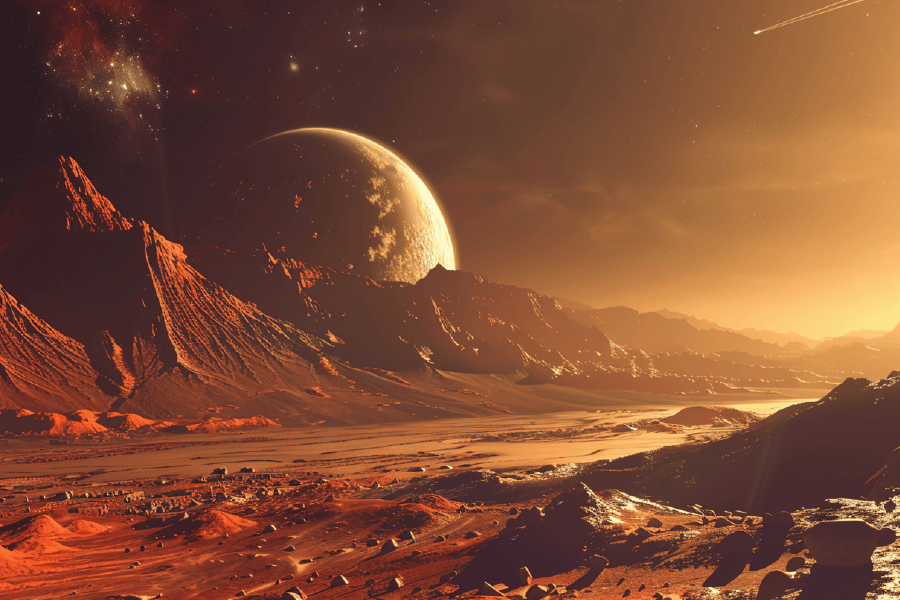Mars experiences quicker leakage when it is nearer to the sun.

– Introduction: Understanding Mars’ Atmospheric Dynamics
Mars, commonly known as the Red Planet, features an atmospheric composition that is both fascinating and puzzling. Unlike Earth’s consistent layer of gases, Mars’ atmosphere is thin and constantly changing due to various cosmic forces. While it revolves around the sun, variations in solar radiation significantly influence its atmospheric behavior; this interaction can result in swift alterations in temperature and pressure that impact gas retention on the planet. Notably, during its close passes with the sun—a phenomenon termed perihelion—Mars undergoes heightened ultraviolet radiation that accelerates the loss of lighter molecules from its atmosphere.
The consequences of these atmospheric transformations are significant. Recent research indicates that during perihelion phases, loss rates can soar by up to 50%, leading scientists to rethink theories regarding Martian climate stability across ages. This increased leakage not only transforms our comprehension of historical Martian conditions but also raises inquiries about possible habitability for upcoming exploratory missions. Moreover, investigating how these astronomical elements affect Mars paves the way for exploring exoplanets.
The Importance of Sun’s Proximity
The Sun’s closeness significantly influences the atmospheric dynamics of planets, especially Mars. When Mars moves nearer to our star, it not only faces heightened solar radiation but also escalated solar wind activity. This influx of energetic particles can rapidly deplete atmospheric molecules, complicating the planet’s ability to preserve its tenuous atmosphere. Grasping this relationship between distance and atmospheric preservation is essential to unraveling Mars’ climatic past and its potential for supporting life.
In addition, this occurrence prompts captivating contrasts with Earth. As we investigate our own solar system, scientists must recognize how Earth’s safeguarding magnetic field has enabled us to flourish despite fluctuating solar proximities. Studying Mars’ susceptibility highlights why preserving an adequate atmosphere is crucial for any chances of life beyond our planet. As researchers persist in untangling the complex interactions among celestial bodies, insights gained from Mars can better guide future space exploration initiatives and deepen our understanding of other exoplanets facing similar challenges linked to their stellar environments.
How Mars Loses Its Atmosphere
Mars’ atmosphere, although sparse, endures a constant struggle against the unyielding forces of space. As the planet moves closer to the sun, solar winds—streams of charged particles released by our star—become more powerful and cause disruption within its atmospheric layers. When nearer to the sun, these solar winds grow stronger, facilitating the erosion of Mars’ fragile gases through a mechanism known as atmospheric escape. This dynamic interaction prompts essential inquiries regarding how Martian geology and its potential for life may have been influenced during eras marked by warmer and wetter conditions.
Recent research indicates that in these periods of increased solar activity, greater amounts of hydrogen and other lighter elements could have vanished into space even more rapidly than previously realized. The implications are significant: if ancient Mars possessed a denser atmosphere capable of retaining water—and thus potentially fostering microbial life—its eventual depletion could account for the arid state we observe today. Studying this phenomenon not only deepens our comprehension of atmospheric loss.
Solar Wind and Its Effects on Mars
The interaction between solar winds and Mars is a complex interplay of cosmic forces that significantly impacts the Red Planet’s atmospheric behavior. As Mars nears perihelion—the point in its orbit closest to the sun—solar winds become stronger, eroding more of its fragile atmosphere. At this moment, charged particles from the sun strike the Martian surface more often, worsening the planet’s ongoing battle against atmospheric loss. This occurrence not only speeds up atmospheric depletion but also provides valuable insights into Mars’ climatic history and possibilities for supporting life.
Interestingly, recent research indicates that these solar winds do not solely cause erosion; they may also engage with Martian surface materials in surprising ways. For example, during spikes in solar activity, distinct chemical reactions may take place at ground level, resulting in temporary formations like perchlorates—compounds associated with liquid water that could harbor microbial life. Moreover, by investigating how solar storms affect dust movement across Martian terrains, scientists are revealing new understanding of seasonal variations and even possible climate.
Seasonal Changes in Martian Climate
As Mars travels in its orbit closer to the Sun, it undergoes significant seasonal variations that greatly affect its climate. The planet’s irregular orbit indicates that when it nears perihelion, its nearest point to the Sun, temperatures can soar sharply compared to other periods of the year. This change leads to extensive sublimation of polar ice caps made up of carbon dioxide and water ice, resulting in not only a temporary rise in atmospheric density but also contributing to intense dust storms capable of covering vast areas—occasionally even affecting the entire planet.
Surprisingly, these dust storms create a complex feedback mechanism within Mars’ atmosphere. As warm winds elevate tiny particles into the atmosphere, they capture more sunlight and further increase surface temperatures, worsening melting conditions at the poles. This recurring cycle suggests possible habitats for microbial life by establishing brief environments where liquid water might appear—an exciting possibility as scientists examine data from landers and rovers for evidence of ancient life. Additionally, grasping Martian seasonal transformations offers essential
Evidence from Recent Space Missions
Recent space explorations, especially those by NASA and the European Space Agency (ESA), have yielded a wealth of data shedding light on Mars’ atmospheric dynamics. Equipment aboard the Perseverance rover and the Trace Gas Orbiter has enabled researchers to directly observe the planet’s seasonal variations in gas composition and atmospheric pressure. Significantly, these missions have shown that carbon dioxide levels vary substantially as Mars nears perihelion, its closest approach to the sun, resulting in intensified solar radiation effects that can accelerate volatile escape into space.
Furthermore, imagery from HiRISE (High-Resolution Imaging Science Experiment) has revealed intricate details about Martian surface features that support theories regarding climate-driven erosion processes. As these features undergo increasing changes during phases of elevated solar exposure, they provide insights into historical conditions on the planet’s surface. This data implies a complicated relationship between solar activity and Martian geology—offering not only a glimpse into environmental dynamics but also deepening our understanding of possible habitability across various epochs.
Comparative Analysis with Earth’s Atmosphere
When we explore the atmospheric dynamics of Mars in relation to Earth, notable differences arise that emphasize the fragility of Martian air. Earth’s atmosphere, mainly consisting of nitrogen and oxygen, serves as a strong barrier due to its substantial gravitational force and magnetic field. In contrast, Mars’ tenuous atmosphere—over 95% carbon dioxide—faces challenges from both reduced gravity and an almost non-existent magnetic shield, leading to rapid atmospheric loss during solar flares or when it swings closer to the Sun. As solar radiation increases with proximity, the lost gases are replenished at a much slower pace on Mars than how Earth maintains its own.
The consequences of this contrast go beyond simple composition; they offer perspectives on historical climate trends. While Earth has preserved a relatively stable environment suitable for life for billions of years, Mars shows evidence of having once possessed denser atmospheres and possible surface water—a reality that technology-driven investigations continue to uncover. The swift gas loss experienced by Mars at perihelion indicates not only.
Implications for Future Mars Exploration
The latest discoveries regarding Mars’ accelerated atmospheric loss when it is closer to the Sun provide crucial insights for future exploration endeavors. Grasping these dynamics may alter our strategies for terraforming and establishing long-term human settlements. Rather than just planning short-term bases, researchers might now have to explore more sustainable methods for sustaining livable conditions on Mars.
Additionally, this fresh data highlights the critical role of timing in mission preparation. If atmospheric conditions vary significantly with the seasons, choosing launch windows that align with periods of optimal environmental stability could improve the effectiveness and safety of subsequent missions. Tools crafted to observe and possibly adjust atmospheric pressure may be prioritized in future journeys, promoting a greater understanding not only of Mars but also of exoplanetary atmospheres influenced by similar stellar factors. The ramifications go beyond basic survival; they prompt us to reconsider what is achievable for humanity’s presence on other planets within our solar system and beyond
Conclusion: Insights into Martian Atmospheric Behavior
The study of Martian atmospheric phenomena uncovers a complex relationship between solar distance and gas preservation, contradicting long-standing beliefs about the planet’s dry condition. As Mars draws nearer to the sun, its atmosphere becomes increasingly variable—heightening both heat escape mechanisms and possible chemical interactions within its sparse air. This swift loss serves as a reminder that planetary atmospheres are dynamic; they are influenced by changing stellar conditions that can significantly alter their makeup over time.
Furthermore, the consequences of Martian atmospheric changes extend beyond mere scientific intrigue; they provide valuable insights into planetary development and habitability throughout the universe. Comprehending why Mars experiences greater volatile losses during specific orbits could guide future missions focused on terraforming or colonization initiatives. Additionally, this understanding might reshape our search for life prospects on other celestial bodies by indicating trends in how exoplanets could similarly engage with their stars—further blurring distinctions between habitable regions and barren expanses in our endeavor to understand life’s diverse forms across the cosmos.
Recent Posts
-
Advice for achieving a healthier and more joyful lifestyle
September 16, 2024 -
Brazil: The premier location for thrilling adventures
September 14, 2024




